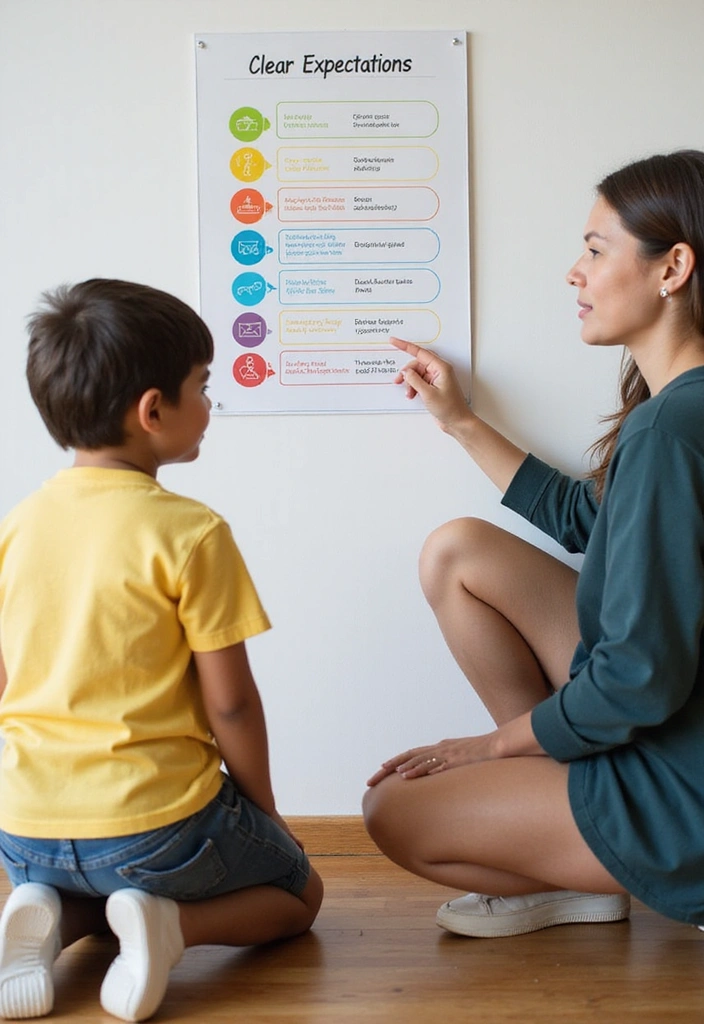Empower your child with strong emotional intelligence! Discover 16 powerful ways to build empathy, resilience, and self-awareness. Technique #9 will amaze you!

Raising emotionally intelligent kids isn’t just about helping them understand their own feelings, it’s about preparing them to face the world with empathy and confidence.
Emotional intelligence, often shortened to EQ, is the ability to recognize, understand, and manage our emotions while also recognizing and influencing the emotions of others.
In today’s fast-paced world, these skills are more crucial than ever, as children face challenges that require both emotional insight and social skills.
From simple daily practices to deeper conversations, fostering emotional intelligence is a journey that can be fun and rewarding. Let’s explore 16 engaging ways to nurture this important aspect of your child’s development!
1. Start with Self-Reflection

Encouraging your kids to reflect on their own feelings is the first step towards emotional intelligence.
Create a cozy space where children can sit quietly and think about their day. Ask guiding questions like, ‘How did that make you feel?’ or ‘What do you wish had happened differently?’
This practice not only helps them articulate their emotions but also teaches them to be mindful and aware.
Make it a habit by incorporating a short reflection time before bed, where they can express their thoughts in a journal or share them with you.
This simple exercise cultivates self-awareness, allowing them to understand their own emotional responses better, setting the foundation for healthy emotional growth.
2. Encourage Open Communication

Create an environment where your kids feel safe expressing their feelings without fear of judgment.
Techniques like active listening and validating their emotions can make a significant impact. When they share their worries, responses like ‘I understand that must be tough for you’ can reassure them that their feelings matter.
Try setting aside time each day for family conversations without distractions. This practice not only builds trust but also strengthens your family bond.
Encourage them to use ‘I’ statements to express how they feel, for instance, ‘I feel sad when…’ This empowers them to articulate emotions, paving the way for effective communication skills later in life.
3. Model Emotional Awareness

Kids learn a lot by watching their parents. If they see you handling your emotions with grace, they are likely to do the same.
Share your feelings openly; if you had a tough day, talk about it. Explain how you felt and what you did to cope. This real-life demonstration shows them that it’s okay to have a range of emotions and that expressing them is healthy.
Use family outings or quiet moments as teachable moments where you can illustrate empathy, frustration, joy, or sadness. Discuss how you recognize your emotions and the steps you take to manage them. Your openness will encourage them to mirror your healthy emotional practices.
4. Use Stories to Teach Empathy

Storytelling is a powerful tool for teaching kids about emotions and empathy.
Choose books and stories that highlight diverse experiences and emotional challenges. Ask questions during and after reading to help them think critically about characters’ feelings.
For example, after finishing a book, ask, ‘How do you think that character felt?’ or ‘What would you have done in their situation?’ This encourages them to step into someone else’s shoes.
Storytime can also lead to deep discussions about right and wrong, enhancing their moral understanding. You can start a family book club where each member chooses a story that resonates with them, promoting an open dialogue about feelings.
5. Play Emotion Games

Games can be a fun and dynamic way to foster emotional intelligence. You can play charades to act out various feelings, encouraging kids to decipher and express emotions through body language.
Another engaging game involves using emotion cards, where each participant draws a card showing an emotion and must share a time they felt that way. This not only gets them talking but helps them make connections with their own experiences.
Consider using board games that involve teamwork and strategy; they often require players to negotiate, argue, or cooperate, providing ample opportunity to practice emotional skills. Games are not just fun—they’re an effective learning tool.
6. Teach Problem-Solving Skills

Help your kids approach problems with a calm and solution-focused mindset. Start by guiding them through conflicts with friends or challenges at school.
Encourage them to identify the problem, think of possible solutions, and evaluate the outcomes of each option. This process not only builds critical thinking but also teaches them to manage frustration and disappointment.
Introduce ‘What would you do?’ scenarios and discuss various responses together. This practice can empower them to handle situations in real life with emotional intelligence, leveraging their ability to think critically about their own feelings and those of others.
7. Encourage Gratitude

Practicing gratitude is a wonderful way to enhance emotional intelligence by shifting focus from negative feelings to positive ones.
Work together to start a gratitude journal where each family member notes things they are thankful for, fostering an appreciative mindset.
Discuss how gratitude can positively influence mood and relationships. Try expressing gratitude during family meals or before bedtime.
You can also create a gratitude wall where family members can post notes about what they appreciate about one another. This builds a sense of community and reinforces positive emotional connections.
8. Create Emotionally Safe Spaces

Make sure your home is a sanctuary for emotional expression. This means creating an atmosphere where feelings can be shared openly and freely.
Designate a specific area in your home where family members can go to vent or talk about their feelings. You could include soft pillows, calming colors, and comforting items in this space.
Encourage your kids to use this area when they need a moment to themselves or when they’re feeling overwhelmed. This strategy teaches them to identify when they need emotional space, which is essential for emotional regulation.
9. Role-Play Different Scenarios

Role-playing various social situations can be an effective way to teach emotional intelligence.
Set up scenarios, such as dealing with a friend who’s upset or having to share a favorite toy. Discuss what feelings might arise and how to respond effectively.
This practice allows kids to practice empathy and develop responses that they can use in real life, plus it builds their confidence in handling social situations. You can take it a step further by filming the role-play, allowing them to review and discuss their performance. This reflective practice can be enlightening and fun!
10. Encourage Emotional Expression Through Art

Art is a fantastic outlet for expressing emotions. Encourage your kids to draw, paint, or create collages that express how they feel.
Art can serve as a silent language, helping children articulate complex feelings they might struggle to verbalize. You can join in the creative process, working alongside them, which strengthens your bond and opens up conversations.
After finishing their artwork, ask them to explain their piece. This not only provides insight into their emotional state but fosters creativity and self-expression. Consider displaying their art prominently to reinforce their feelings of pride and achievement.
11. Celebrate Emotional Milestones

Recognizing and celebrating when your kids navigate emotional situations successfully is crucial. Whether they express their feelings clearly for the first time or handle disappointment well, acknowledging these moments reinforces their learning.
Create a special tradition, like a ‘feelings celebration’ night, where you gather to share stories of emotional growth. This practice builds self-esteem and encourages them to continue developing their emotional intelligence.
You could even create certificates for achievements related to emotional milestones, making them feel proud of their progress in this essential life skill.
12. Teach Mindfulness Practices

Mindfulness is a powerful tool for emotional regulation. Implement fun mindfulness exercises like breathing techniques or guided imagery to help your kids manage their emotions.
These exercises can be short and engaging; for example, you can take a minute to breathe together, counting to five as you inhale and exhale.
Introduce mindfulness apps designed for kids or practice daily mindfulness moments, such as being aware of the sounds around you during a car ride. This approach teaches them to pause and reflect before reacting, an essential aspect of emotional intelligence.
The calmness they gain from these practices can help them in challenging emotional situations.
13. Encourage Acts of Kindness

Encouraging your kids to perform acts of kindness can enhance their empathy and emotional understanding. This could be as simple as helping a friend or assisting with household chores without being asked.
Discuss the impact of their actions on others’ feelings and the joy that comes from helping someone in need. Organize community service projects together to provide them with real-life experiences of giving back.
This practice not only builds emotional intelligence but also nurtures a sense of belonging and purpose, vital for healthy emotional development.
14. Use Technology Wisely

In today’s digital age, using technology wisely can support emotional intelligence development. There are various apps and online resources designed to teach kids about emotions and empathy through games and interactive activities.
Encourage them to use these tools to enhance their understanding of emotional situations in a fun way. Set aside tech-free family time to discuss feelings or play non-screen games.
Balance is key; while technology can be a useful resource, it’s equally essential to ensure that kids engage in face-to-face interactions that build their emotional skills.
15. Be Patient and Supportive

It’s vital to remember that developing emotional intelligence is a journey that takes time and patience. Celebrate small victories, and be there to guide them through tougher moments without judgment.
Let them know that it’s okay to make mistakes along the way; every misstep is a learning opportunity.
Encourage them to talk about what they learned from each experience. Foster resilience by reminding them that they can always try again, no matter how daunting a challenge may feel. Your unwavering support helps them build their emotional toolkit, preparing them for life’s ups and downs.
16. Foster Independence

Encouraging kids to make their own decisions can significantly enhance their emotional intelligence. This allows them to experience the outcomes of their choices, building responsibility and emotional awareness.
Let them choose their clothes, select activities, or even decide on family outings occasionally. Discuss their choices and the emotions tied to these decisions. Empowering them to find solutions fosters confidence and self-reliance, essential traits of emotionally intelligent individuals. Remember, it’s important to guide them through this process while allowing them the freedom to make mistakes.
Here Are We Go!

Fostering emotional intelligence in your children is a fulfilling journey that shapes their future relationships and well-being.
By integrating these practices into daily life, you help them develop essential skills that prepare them for the world ahead.
As you embark on this adventure, remember, the most important thing is to create a nurturing environment where emotions can be expressed and understood freely. Celebrate every step of their emotional growth!







